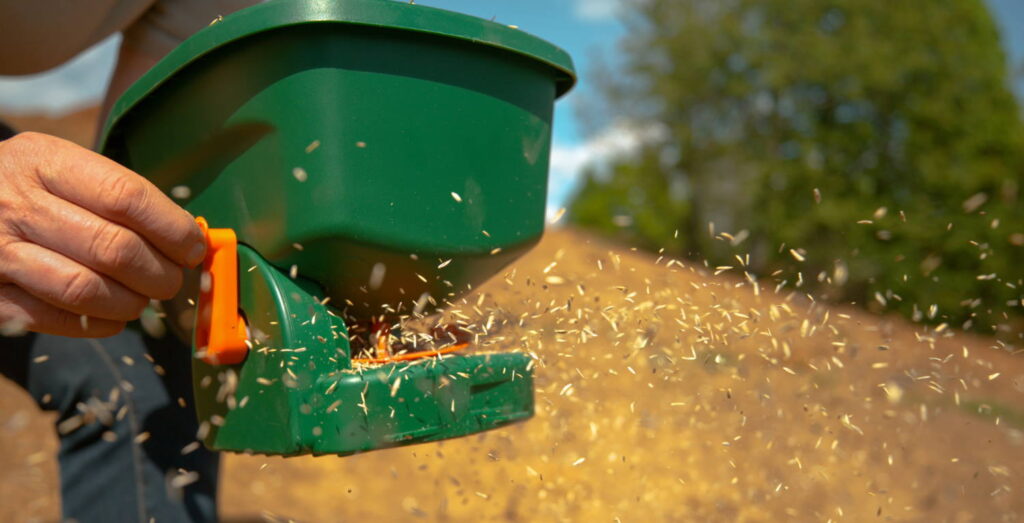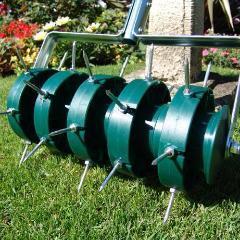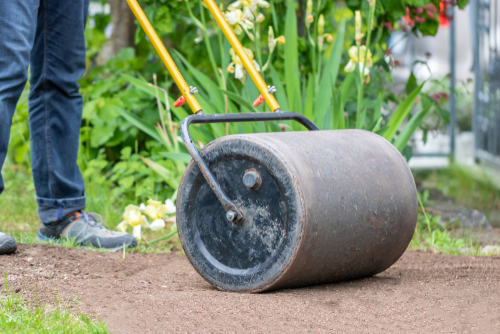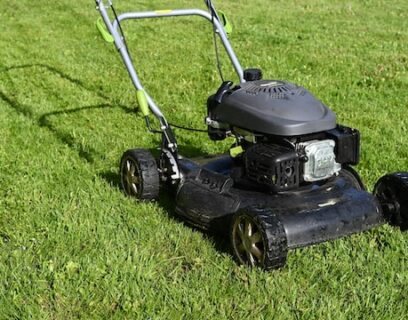Log in or create new account to save this product to your wishlist.
How to overseed your lawn (and why you should do it!)
If you've got bald spots on your lawn after the winter, it could be time to overseed. But make sure you prepare the soil beforehand.
Latest articles
7 MIN 22 Jul How to keep your lawn in shape this summer 9 MIN 15 Jul Watering Your Garden: 10 Top Tips! 11 MIN 15 Jul Is Your Grass Type Right for your Garden? 11 MIN 10 Sep Create Your Low-Maintenance Garden – Tips and Ideas 11 MIN 08 Sep The Ultimate Guide to Choosing the Perfect Hedges for Your Garden 12 MIN 30 Aug The Top 20 Evergreen Climbers to Transform Your GardenDoes your heart sink a little when you look at your lawn? It could be that your grass plants need some help. All lawns need regular fertilisation (at least three times a year), but if your lawn is thinning, no amount of fertiliser is going to remedy the situation. In this case, you need to overseed your lawn.
- Why is overseeding your lawn so important?
- When is the right time to overseed my lawn?
- Overseeding during spring
- Overseeding in the summer
- Overseeding in autumn
- How to overseed your lawn – a step-by-step guide
- Overseeding your lawn: the checklist
- FAQ
Overseeding is a simple process that provides excellent results in very little time. So, it’s a mystery why most of us never think to give our lawns a boost with fresh seed.
This article is all about how to overseed your lawn – making light work of this simple task for exceptional results in just a couple of weeks. We’ll explain how (and when) to overseed – for optimal results every time.
Let’s get to it.
Why is overseeding your lawn so important?
Everything dies eventually. It’s a tragic truth, as sure as – well, death and taxes.
And like everything else in life, your grass plants weaken as they grow older. And while you can expect a lifespan of around 15-20 years from your turf, eventually, it will lose resistance and succumb to weeds, moss, and disease.
But it’s very possible to rejuvenate your lawn without ripping it up and re-turfing from scratch – and the answer is overseeding.
However, it’s better to overseed regularly than to leave your lawn until it’s looking worse for wear. This all-important task is something we should all do – don’t wait until your grass plants are dying before you overseed.
Overseeding is the process of sprinkling new lawn seed over your old lawn. Don’t give weeds and diseases a chance to take hold – keep your lawn healthy with regular overseeding.
When is the right time to overseed my lawn?

The conditions need to be correct for grass seed germination: the soil temperature must be at least 10°C. Bear in mind that soil warms up much more slowly than the air, so UK soil is unlikely to warm up to 10°C until at least mid-March.
Of course, it depends on the ambient temperature, and we all know that British weather is unpredictable at best. The surest way to identify whether your soil is warm enough is to use a soil thermometer. Once it’s 10°C, it’s likely to stay that way for long enough to germinate your grass seed (unless there’s a freak cold snap, of course).
Soil warms up more slowly than the air, but it also holds onto its temperature for much longer than the air. So, wait for the air temperature to hit a regular 13°C for a couple of weeks to be sure.
The best times for overseeding your lawn is at the beginning of spring or the autumn when your lawn experiences the least footfall. You can, of course, overseed during the summer, but you should avoid walking on young grass plants for at least a month after it’s sprouted. Also, summer is likely to be hotter and drier during summer, so you’ll need to water more regularly to strengthen your young grass plants during the warmer months.
Overseeding during spring
Your lawn awakens from its winter dormancy in early spring. Once the temperature rises, your lawn starts growing again. And even though grass plants are pretty resilient to harsh winter conditions, you may notice that your spring lawn has developed patches of bald spots.
The best way to give your spring lawn a fighting chance in spring is to make sure you fertilise at the end of the autumn. That way, your grass plants are strong and healthy before they sleep over the winter.
Nonetheless, all lawns need a little extra attention in the spring. And most lawns benefit from overseeding.
But, wait for the soil temperature to reach 10°C before you overseed.
Overseeding in the summer
You can overseed during the summer, as long as the mercury hasn’t risen above 25°C. If it is warmer than 25°C, you’ll need to take extra care that your seedlings don’t dry out. Make sure you water regularly if you’re overseeding during the summer.
Overseeding in autumn
If you’ve used your lawn heavily during the summer, it’s wise to fertilise your soil before you overseed.
And while it’s difficult to predict British weather, autumn tends to be cooler and wetter than summer, making it the perfect time to spread new lawn seed over your existing lawn.
How to overseed your lawn – a step-by-step guide

1. Buy your lawn seed
Before you set out on your overseeding project, treat yourself to some high-quality grass seeds. It’s salient to emphasise the importance of buying a good-quality seed, which is likely to have a higher germination rate.
MOOWY lawn seeds are expertly prepared and packaged, selected from high-quality sources. In fact, our seeds are manufactured by the same factory that produces lawn seed for professional football stadiums.
MOOWY’s premium-quality grass seeds provide longevity for your new grass plants, germinating within 7-14 days and quickly growing into a healthy, dense turf. Check out our guide to buying grass seed to make sure you pair your garden’s conditions with the right type of grass.
2. Mow your lawn before you overseed
Before overseeding, mow your lawn to around 2-3cm. This will remove the majority of the old grass, making room for new grass plants. Ensure the grass is dry before you mow to prevent tearing the blades.
However, always ensure that you stick to the most crucial rule of mowing your lawn:
Never cut your grass more than ⅓ of the grass blades’ full length
Grass seed needs to make good soil contact to germinate. Therefore, mowing creates space for your new grass shoots to spread more densely and quickly.
If your grass is short, your grass seed is more likely to make contact with the soil; otherwise, you’re just laying a tasty treat for the birds on top of your existing lawn.
3. Improve your soil

Before you overseed, examine the soil around the bald spots in your lawn. Does water drain down into the earth, or does it create a puddle?
If you get puddles in the bald spots, it’s pretty safe to assume that the soil is too hard and compacted, which is likely if you have heavy clay soil. Grass thrives in light, aerated soil, so it’s time to loosen up the soil before you overseed; otherwise, your new grass plants will fail to prosper.
The simplest way to aerate your soil is with a lawn aerator or a hollow tine aerator tool. These tools puncture holes in the soil surface, which breaks up compacted soil while providing air, light, and water to the earth – everything your grass needs to thrive. For heavily compacted soil, it’s a good idea to fill the new holes with gardening sand and drive a rake over the surface before overseeding.
Check out our expert’s guide to aerating your lawn for more info.
However, your soil might be OK, but your grass is still struggling to survive. In this case, examine the space between the grass tips and the soil surface. Is there a layer of moss? Are weeds overtaking your lawn?
If you’re losing your lawn to moss and weeds, it’s a good idea to scarify your lawn, which is an intensive make-over of the soil. Check out our step-by-step guide to scarifying your lawn before you overseed.
Whether you’re aerating or scarifying before you overseed your lawn, make sure you level out the soil surface to prevent a bumpy lawn.
4. Overseeding your lawn
Now it’s time to get to work. Ensure that the soil temperature is at least 10°C and well-watered – never overseed your lawn on dry soil; the seed may blow away in the wind.
- Calculate how much seed you’re going to need: sow 17g of seed per square metre when overseeding. If you’re sowing from scratch, you’ll need double the amount of seed.
- Measure out your seed and divide it into two halves.
- Distribute the first half evenly widthways across the patch.
- Distribute the second half lengthways across the patch.
You can sprinkle lawn seed by hand, but it can be challenging to lay the seed evenly. For best results, use a seed spreader.
5. Press the seed into the soil

Your soil will only germinate if it makes contact with the earth. So, once you’ve distributed your seeds, press them into the soil surface.
Rake the seeds gently into the soil surface. Your grass seeds shouldn’t be covered by soil, but they should be in good contact with the earth. Shake off any seeds that stick to the tines of your rake.
If you have a seed roller, press the seed onto the soil with some gentle pressure. You don’t need the weight of one hundred elephants here – just some gentle pressure.
If you don’t have a roller, tap the seeds onto the soil with a plank of wood – again, applying gentle pressure.
6. Fertilise the soil
You want to give your new grass plants the best chance of survival, as young shoots are vulnerable. So, ensure that the soil is well-nourished. However, it’s better to fertilise around four days before you overseed to prevent a reaction with the fertiliser that could prevent germination. If you haven’t already fertilised, skip this step and fertilise four days after overseeding to avoid problems.
Use our Lawn Starter fertiliser to boost the nutrient level of your soil, making it as hospitable to new growth as possible.
Use 25g per square metre, distributing the fertiliser in two halves in the same way as you sprinkled your seeds.
7. Water!

It goes without saying that your new grass plants are going to need water! So, water your lawn immediately after fertilising – this prevents the granules from shifting in the wind.
Also, fertiliser granules can get stuck in tall grass, which can scorch the leaves – so watering helps the granules reach the soil.
Water your lawn four times a day until the seeds have germinated. This is important – water little and often. If you water in large amounts, the seed is likely to wash away, and you’ll get patchy results.
Watering helps activate your fertiliser and gets the nutrient load down into the soil, ready to help develop new grass roots.
8. Wait!
You don’t plant an acorn and expect an oak tree the very next day. Likewise, practice patience in allowing your grass plants to develop.
Avoid walking on new grass shoots – they’re very vulnerable at first and can quickly die if trampled.
So, keep an eye on your new grass plants as they germinate. You might need to cordon the area if your pet has taken a fancy to the fresh spot of grass – cats, especially, seem adept at finding all the wrong places to lie, don’t they!?
Wait at least 14 days after germination before you mow your new grass plants. Mowing helps strengthen your grass plants, so don’t leave it longer than a month before the first mowing to initiate the plant into the routine of damage and repair.
Remember, don’t remove more than ⅓ of the overall length in one go – it could irreparably damage your young plants.
Ensure that your cutting blades are sharp – blunt blades will tear the grass and damage the young plant.
Overseeding your lawn: the checklist
You’ll need the following items to overseed your lawn:
- Lawnmower
- Sand (potentially)
- Grass seeds
- Hand spreader
- Rake
- Roller
- Fertiliser
- Garden hose, sprinkler, or watering can
- Patience!
Are you ready to overseed your lawn?
Hopefully, you feel better informed and can confidently go about your first overseeding project. But if you have any questions, please get in touch.
We love hearing from you, and we promise to get back to you as quickly as possible. We’re looking forward to hearing from you.
Thanks for reading!
FAQ
Absolutely. This is called “overseeding” and is the process of growing new grass plants to cover bald spots in your existing lawn.
Overseed at the rate of 17g/m2. Too much seed causes lower germination rates and weak plants due to overpopulation and demand for soil nutrients.
It’s best to wait around 4 days after overseeding before you fertilise. Otherwise, the fertiliser may stop the seed from germinating. If you need to do it at the same time, make sure you use a fertiliser developed for young lawns, such as MOOWY’s Lawn Starter.
A: It’s best to wait around 4 days after overseeding before you fertilise. Otherwise, the fertiliser may stop the seed from germinating. If you need to do it at the same time, make sure you use a fertiliser developed for young lawns, such as MOOWY’s Lawn Starter.
Leave a comment
Your answer will be displayed on the site and the interested party will be notified by email.
Leave a comment
Have a question or want to share your experience? Leave us a comment.
Read more
The best tips and tricks for a lush green lawn
 Scarifying Kit
All products after scarifying | Quickly restores the lawn after scarifying | Outsmart weeds quickly with the use of this kit
From: € 39.99
Scarifying Kit
All products after scarifying | Quickly restores the lawn after scarifying | Outsmart weeds quickly with the use of this kit
From: € 39.99
 Spring Lawn Care Kit
MOOWY’s choice for the spring | Quick recovery of your lawn after winter | A strong lawn prevents weeds
From: € 25.99
Spring Lawn Care Kit
MOOWY’s choice for the spring | Quick recovery of your lawn after winter | A strong lawn prevents weeds
From: € 25.99
 Long Lasting Lawn Fertiliser
Effective for 90 days | See results in 14 days! | Suitable for all types of grass and soil
From: € 13.99
Long Lasting Lawn Fertiliser
Effective for 90 days | See results in 14 days! | Suitable for all types of grass and soil
From: € 13.99
Do you want a lawn calendar?
🌱 All important maintenance moments for your lawn during the year. Leave your email and we will send you the lawn calendar for free.
Enter your email
Receive the lawn calendar in the mail
Enjoy a green lawn all year round!













Comments (0)
There are no comments yet. Well then, what are you waiting for to
Be the first to write your comment!inaugurate this pretty page?
Do you have some comments?